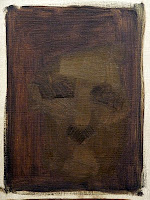The purpose of this painting was to study the light on the model and mix the exact value, temperature and color spot, then apply it in a stroke. No blending, no "licking" (a term used to describe repeated strokes in the same area). If a color spot is wrong, it must be scraped and repainted, but the goal was to make any mistakes on the palette. By the time the brush was touching the canvas, all the guesswork should have been done.
There is such an energy between the model and the artist when this kind of work is going on. The model is working to keep the pose and the artist is working to capture the pose, so they're unified in their purpose and exerting great electric fields of concentration. The main difference in their experience, having sat in both seats myself, is that time passes very slowly for the model and unbelievably quickly for the artist. That's why the model should be the time-keeper.
Monday, December 12, 2011
Saturday, December 10, 2011
Madame G
Madame G reminds me of John Singer Sargent's Madame X.
She's one of my favorite models and I painted her all day recently, studying the non-linear approach to portrait painting.
In the top shot, you see her on the model stand in the background. In the foreground, you see my stage-2 effort to capture her. Stage-2 is the light and shadow shapes, plus the next dark and next light shapes. For the most part, the color on her cheeks and lids is the same value and temperature as the light.
Beneath that is a canvas that I used half of in the morning and half of in the afternoon. The morning work is the upsidedown image on the left, showing my first stage-1 effort. My purpose at this stage was to show only the shape of the light as it bathed her face and dark value shape surrounding that. Rightside-up-side is a shot of stage-3 from later that same day. The details were just beginning to reach expression: more value and color were added to the light shape, letting the contours of her face emerge. Had I continued, I would have next blocked in the light of her hair and then the background. I only hope that this beautiful woman would have become more and more beautiful on the linen, that I might return the honor of her posing. Thanks for your visit.
She's one of my favorite models and I painted her all day recently, studying the non-linear approach to portrait painting.
In the top shot, you see her on the model stand in the background. In the foreground, you see my stage-2 effort to capture her. Stage-2 is the light and shadow shapes, plus the next dark and next light shapes. For the most part, the color on her cheeks and lids is the same value and temperature as the light.
Beneath that is a canvas that I used half of in the morning and half of in the afternoon. The morning work is the upsidedown image on the left, showing my first stage-1 effort. My purpose at this stage was to show only the shape of the light as it bathed her face and dark value shape surrounding that. Rightside-up-side is a shot of stage-3 from later that same day. The details were just beginning to reach expression: more value and color were added to the light shape, letting the contours of her face emerge. Had I continued, I would have next blocked in the light of her hair and then the background. I only hope that this beautiful woman would have become more and more beautiful on the linen, that I might return the honor of her posing. Thanks for your visit.
Tuesday, December 6, 2011
Go Figure
I promised you I'd cover the Clayton Beck workshop and all I learned there. This was my favorite: paint small, quick studies working up from the darkest light and the lightest dark on the model. It required the most strict concentration and restraint on my part but it forced my brain to actually understand some things that it only thought it understood until now. These flanking paintings were the most successful, in my opinion. The more detail I added in these paintings, the weaker they got and the less I liked them. Food for thought.
Subscribe to:
Posts (Atom)









